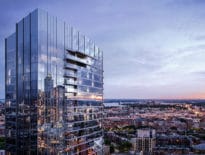
MetroWest multifamily properties are attracting interest from out-of-state investors looking for superior returns and betting on continuing rent growth. San Francisco-based FPA Multifamily paid $130 million in June for the Fountainhead apartments in Westborough. Photo courtesy of CBRE
With high-paying jobs, a wealth of recreational and cultural activities, and world-renowned educational institutions, Greater Boston is a magnet for global talent and draws professionals from around the world. This rapid migration coupled with job formation is one of the driving forces that has helped keep the Boston multifamily market thriving.
Even though capital markets remain liquid with U.S. “dry powder” exceeding $210 billion, there continues to be significant interest in multi-housing across the entire United States. Late cycle awareness is pushing more capital towards the Greater Boston market since the multifamily fundamentals are outpacing other primary markets in the U.S.
Greater Boston: By the Numbers
Greater Boston is the number one location for life sciences in the U.S., has the third highest jobs-per-resident ratio of any U.S. city, witnessed a 5.5 percent growth in employment base in 2018 and recently showed more than a 10 percent annual growth in its high-tech sectors. The current unemployment rate is just 2.4 percent, well below the national unemployment rate of 3.6 percent.
Total multi-housing transaction volume in 2018 in Greater Boston totaled roughly $2.18 billion, down nearly 25 percent year over year. In 2018, the market did not see a lot of core multi-housing buying opportunities, and this trend is expected to remain in 2019. Investor demand continues to outweigh supply, creating a scarcity premium for trophy assets in downtown Boston and driving core cap rates below 4 percent and pricing above $1,000 per square foot. Investors have positioned Boston at the top of their target lists for multifamily acquisitions and, with a slow transactional start to 2019, we expect to see continued upward pressure on sales prices.
While value-add properties continue to be highly sought after by private and institutional capital, investment is increasingly shifting to core-plus product due to limited value-add opportunities. Additionally, much of the new construction buying opportunities are in suburban locations, and we are seeing more institutional investors look to the suburbs to deploy capital into multifamily assets. As a result, suburban cap rates are beginning to converge onto core cap rates for select, well-located assets. Looking ahead, we expect cap rates to remain low throughout 2019.
Supply Versus Demand
The Boston multifamily supply has been slightly constrained, since annual new supply averaged around 6,700 units between 2014 and 2016. By comparison, the market’s long-term average pre-2014 was approximately 3,200 units annually. In 2018, the market hit a cycle high in terms of completions with more than 8,000 units delivered. In 2019, 6,200 units are expected to deliver while completions in subsequent years further tapering off as the headwind of continually increasing construction costs stymies the economic viability of new development projects.
Despite record new supply deliveries in the Boston MSA, average occupancy remains strong at 96.3 percent as of the first quarter of 2019, while effective rents grew steadily during the past year, achieving 3.2 percent year-over-year growth. Rents averaged $2,256 per month, also as of the first quarter of 2019. Luxury buildings in downtown Boston are reaching record-high rent levels with dollar-per-square-foot rents exceeding $6 per square foot for some units.

Chris Phaneuf
Notable Boston-area transactions in the first quarter of 2019 that demonstrate the significant demand for class A multifamily in both urban and suburban settings, including the Harlo in Boston’s Fenway neighborhood and Modera Hopkinton in Hopkinton. Invesco purchased the Harlo, a 212-unit class A property in Boston’s Fenway neighborhood from Skanska/Prudential for $150 million ($707,665 per unit). In the suburbs, GID purchased Modera Hopkinton, a 279-unit community that was delivered in 2017, from Mill Creek Residential/Elite International Investment for $93 million ($332,857/unit).

Adam Dunn
Looking forward, fundamentals of the Greater Boston market will remain strong. A slowing of deliveries and continued projected job growth will continue to lead to positive absorption, elimination of concessions and increasing rents. With renter demand outpacing supply, we expect to continue to witness healthy multifamily fundamentals going forward.
Chris Phaneuf is a managing director and Adam Dunn is a director for HFF Boston.






